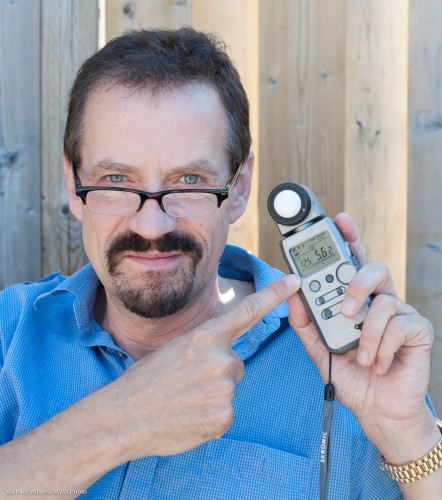Using a light meter, you say, is oldfashioned.
Not so!
- A light meter is fundamentally different from a camera-based meter. The former is an incident light meter and does not depend on the subject’s brightness. The camera based meter, on the other hand, is a reflected-light meter, and hence depends on the subject’s brightness. In fact the camera’s meter can only indicate the right number when you aim it at a grey card (and when using the spot meter, at that).
- For manual flash you can only use a light meter, a so-called “flash meter”.
A modern meter like my Sekonic is both ambient and flash meter.
To use it for ambient light, as I did for the student photo above, do the following:
- Move the white dome all the way out.
- Turn the meter on.
- Using the MODE button, set the meter to ambient metering (the sun symbol). Select the mode where you set the aperture and the meter will indicate the shutter speed. (The F-number has a square around it on the Sekonic). You could also choose to set the shutter speed, and have the meter calculate the aperture instead. But let’s assume here that you choose the aperture and want the camera to calculate the shutter speed.
- Set the ISO to the ISO you choose to use on your camera (200 in the shot above).
- Set the meter’s aperture number to the aperture you have chosen on your camera.
- Hold the meter exactly where the subject will be, facing the camera. Ensure you are not blocking the light that falls onto the meter.
- Click the reset/measure button on the side.
And now you read the shutter speed you need with that ISO and that aperture. (You can change ISO and/or aperture and a new correct shutter speed will be displayed that match those ISO/aperture settings.)
Set that shutter speed on your camera – and you exposure is correct. Spot on.
You see, the benefit of using the meter is that you ace the exposure. Not like the camera meter, where you have to allow for darker-than-a-grey-card subjects (expose less than “0”), or lighter-than-a-grey-card subjects (expose more than “0”). With a light meter, no such adjusting.
Yes, you can use a grey card, and you can use the zone system. Sometimes you have to – mountains do not lend themselves to you running over to them with a light meter. But generally, if you have the time and the light is steady, consider using a meter and be a pro in terms of exposure.

